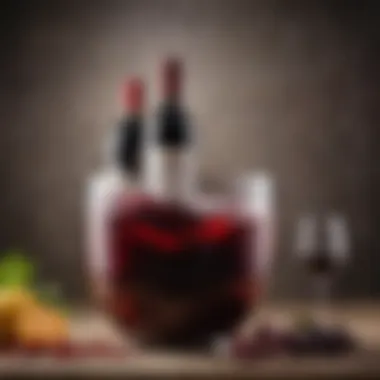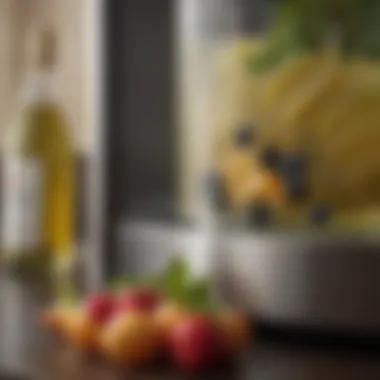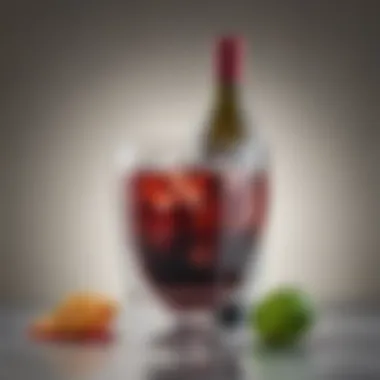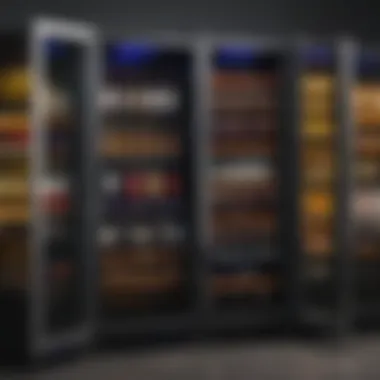Crafting Exquisite Red and White Wine Coolers


Intro
In the realm of beverage creation, the delicate interplay between flavor and presentation often takes center stage. Wine coolers, particularly those made with red and white wines, portray this balance beautifully. Understanding their dynamics allows culinary enthusiasts to create drinks that are not only refreshing but also intriguing in complexity. This exploration reveals much more than mixing beverages. With attention given to wine selection and ingredient pairings, crafting a wine cooler transcends simple preparation.
Wine coolers serve a role in diverse culinary contexts, from casual gatherings to more formal dining occasions. They hold the potential to elevate an experience, fostering conversation and enjoyment among guests. This journey aims to unpack the essential components and techniques involved in preparing red and white wine coolers, presenting an opportunity for enthusiasts to refine their approach and expand their repertoire.
Key details regarding the selection process, creative variations, and practical tips will enhance the reader's understanding, equipping them with the knowledge to impress their audience.
"Crafting a perfect wine cooler is realizing the potential of both the base and the accompanying elements, blending them into harmony."
Recipe Overview
- Recipe Name: Classic Red and White Wine Coolers
- Cuisine Type: Global
Ingredients
List of Ingredients with Measurements
- Red Wine: 2 cups (any fruity variety like Merlot or Shiraz)
- White Wine: 2 cups (a refreshing selection like Sauvignon Blanc or Chardonnay)
- Sparkling Water: 1 cup (to add fizziness)
- Fresh Fruit: 1 cup (sliced oranges, berries, or seasonal fruit)
- Sweetener: 2 tablespoons (simple syrup or honey, to taste)
- Ice Cubes: As needed
Substitutions for Common Ingredients
- Red Wine: Zinfandel or Pinot Noir can replace other red wines.
- White Wine: Alternatives like Riesling or Pinot Grigio work well.
- Sweetener: Maple syrup or agave can substitute honey for those preferring plant-based options.
This foundational understanding of recipes, ingredients, and substitutions sets the stage for more in-depth exploration. With the basics established, we will now delve into preparation techniques and variations that will enhance the craft of creating remarkable wine coolers.
Prologue to Wine Coolers
The topic of wine coolers may seem straightforward, but it encompasses a wide range of considerations that are worth examining. Wine coolers serve a unique purpose within the landscape of beverages, marrying flavors and textures that enhance both casual and formal dining experiences. Understanding this domain provides crucial insights for culinary enthusiasts and food lovers alike.
Wine coolers typically provide a lighter alternative to traditional wine serving methods. Their composition can vary significantly based on the chosen ingredients, allowing for endless creativity. Appreciating its definition and purpose will further enlighten readers about how these beverages can enrich any occasion.
Definition and Purpose
Wine coolers are essentially refreshing beverages made by mixing wine with various ingredients, such as fruits, herbs, and flavored mixers. The primary purpose of a wine cooler is to create a drink that is both enjoyable and easy to consume. It does not require extensive knowledge of wine tasting or pairing, making it accessible for a broad audience.
For many, the appeal lies in the lightness and the potential for customization. The balance of acidity in wine paired with sweet mixers and fresh fruits offers a range of flavors that can cater to various palates. Not only does this versatility make wine coolers appealing, but they also allow room for experimentation, enhancing their significance in social gatherings.
Historical Background
The concept of wine coolers has roots tracing back to the early days of wine consumption. Originally, wines were meant to be enjoyed in their pure form, highlighting their inherent flavors and aromas. However, as culinary trends evolved, so did the ways in which beverages could be enjoyed. The rise of mixology in the late 20th century played a critical role in popularizing wine coolers.
In the 1980s, wine coolers emerged in the mainstream market, characterized by their sweetened flavors and often lower alcohol content. They became a staple in casual social settings, quickly gaining popularity among a diverse demographic. Brands like Bartles & Jaymes captured consumer interest, leading to an increase in ready-to-drink options.
As time progressed, wine coolers transformed from commercially produced mixes to more artisanal versions crafted at home. Consumers began to appreciate the importance of selecting quality wines and complementing them with fresh, natural ingredients. This historical shift underscores the evolving relationship humans have with wine and beverages overall, moving from simple consumption to an appreciation for crafting unique experiences.
Understanding Red and White Wines
Understanding red and white wines is crucial in delving into the world of wine coolers. Each type of wine has distinct characteristics that contribute uniquely to flavor profiles. When combining these wines with mixers and other ingredients, comprehension of these differences enhances the overall experience of crafting a wine cooler. This knowledge allows enthusiasts and casual drinkers alike to make informed choices about their beverage creations.
By recognizing the attributes of red and white wines, one can explore the versatility in pairings and the visual appeal in presentations. The following sections will detail the essential characteristics of both red and white wines, offering deeper insights into how they can elevate wine coolers.


Characteristics of Red Wine
Flavor Profiles
Red wine's flavor profile is typically rich and bold, marked by complex layers of fruit, tannins, and acidity. Common flavors include dark fruits such as blackberry, plum, and cherry, complemented by earthy undertones and hints of spice, depending on the grape variety. This plethora of flavors allows red wine to be a popular choice for creating more robust wine coolers.
A key characteristic of red wine is its tannic structure, which can contribute depth to a wine cooler. Tannins, derived from grape skins, seeds, and oak barrels, provide a slight astringency and can create a balanced contrast to sweeter mixers. While some may find high-tannin wines overwhelming, their bold character is especially beneficial when mixed with more neutral or sweet ingredients in wine coolers, helping to achieve a harmonious blend.
Best Pairings with Food
The best pairings often depend on the body and flavor composition of the red wine. Hearty red wines, such as Cabernet Sauvignon, pair well with grilled meats, rich sauces, and aged cheeses. This affinity for food enhances both culinary and beverage experiences, making red wine a better fit for certain palettes.
One unique feature of pairing red wine with food is that the wine can enhance flavors in dishes and complement textures. However, not all foods are suitable for red wine. Lighter meals may clash with the boldness of red wines, resulting in a less enjoyable experience overall. Therefore, understanding these dynamics is vital when designing wine coolers intended for special occasions or intimate dinners.
Characteristics of White Wine
Flavor Profiles
White wine tends to have a lighter, crisper profile. Flavors in white wines often span from citrus notes in Sauvignon Blanc to buttery or oaky qualities seen in Chardonnay. This diversity makes white wine a versatile option for a range of wine coolers, appealing to varied tastes.
A significant aspect of white wine is its zesty acidity. This quality can add a refreshing burst to wine coolers, making them more revitalizing, especially in warmer weather. The lightness of white wine often makes it a better match for mixers like soda or fruit juices, which can enhance and not overshadow the primary wine flavors.
Best Pairings with Food
When it comes to food pairings, white wine is often associated with lighter fare. Dishes such as seafood, white meats, and salads make excellent companions to white wine, fostering a balanced and complementary dining experience. This characteristic allows for flexibility when crafting wine coolers that are suitable for gatherings or casual meals.
A unique advantage of white wine is its compatibility with fruit-based mixtures, like peach or berry purees, allowing for enhanced flavor integration. However, a disadvantage lies in the potential for white wine to be perceived as less satisfying than heartier reds in certain settings. Thus, understanding and appropriately leveraging these pairing considerations can lead to refined and enjoyable wine cooler creations.
Crafting a Basic Wine Cooler
Crafting a basic wine cooler is the foundation for anyone interested in exploring the broader world of wine-based beverages. This section emphasizes not just the construction of a delightful drink but also the nuanced understanding of ingredients that can elevate the experience. By grasping the essential components, one can develop a keen sense of how flavors interact, creating a balanced and refreshing wine cooler. The implications of mastering this skill extend beyond mere pleasure; it becomes a means of expression and creativity, particularly valuable in social settings.
Essential Ingredients
Wine Selection
Wine selection plays a pivotal role in crafting the perfect wine cooler. The type of wine used sets the tone for the entire drink. Red wines bring robust and rich flavors, while white wines offer crisp and refreshing notes. Choosing the right wine can make the difference between a memorable wine cooler and a forgettable one.
For example, using a fruity Pinot Noir can add a vibrant touch to your cooler, making it a popular choice for those who prefer something not too heavy. Alternatively, Chardonnay often works well in white wine coolers, providing a buttery texture that complements various mixers. The unique feature of wine selection lies in its ability to cater to diverse palates and occasions. It allows customization based on whether one favors sweet, dry, or aromatic wines, thus creating a tailored beverage experience. However, it is essential to consider that a lower-quality wine may affect the final taste, potentially making the cooler less enjoyable.
Mixers and Additives
Mixers and additives are crucial in achieving the intended flavor profile of a wine cooler. These elements enhance the taste and texture while providing depth and complexity. Popular mixers include fruit juices like orange or cranberry, soda, or tonic water. These options add sweetness and carbonation, helping to lighten the drink and balance out the wine’s characteristics.
One of the advantages of mixers is their versatility. They can be adapted to match the seasons or events. For example, using fresh lemonade in summer can create a refreshing drink perfect for hot days. On the other hand, one must be careful with mixers that could overwhelm the wine’s flavor. Too much sweetness or strong flavors can mask the subtleties of the wine, leading to an unbalanced cooler.
Basic Preparation Techniques
Preparation techniques for crafting a wine cooler are relatively straightforward yet require attention to detail. A basic approach involves choosing a suitable glass and ice to maintain the drink's chill.
Once you have your ingredients ready, combine the chosen wine with the mixers in a desired ratio. Typically, a good starting point is two parts wine to one part mixer. Adjusting this ratio allows for experimentation until achieving the preferred taste
It is also important to stir gently rather than shaking. Shaking can aerate the drink excessively, altering the flavor and ruining the intended balance.


In summary, understanding how to craft a basic wine cooler necessitates knowledge of ingredient selection and preparation techniques. The interplay between wine and mixers can create something unique yet easy to enjoy, encouraging creativity in beverage crafting.
Exploring Variations of Wine Coolers
The diversity found within wine coolers is significant. Variations enhance the overall enjoyment of these beverages. Offering something beyond the standard blend allows for creativity and personal expression. Different ingredients can affect flavor, appearance, and aroma. As we delve deeper, we will cover two key categories: fruit-infused and herbal/spiced wine coolers. Each has distinct characteristics that can elevate the experience for both maker and consumer.
Fruit-Infused Wine Coolers
Seasonal Fruits
Using seasonal fruits in wine coolers is a key element that adds freshness and vibrancy. These fruits, like berries or citrus, are at their peak flavor and nutrition during specific times of the year. This characteristic makes them a popular choice for wine cooler recipes. Incorporating seasonal fruits ensures that the drink is both flavorful and relevant to the time of year. The unique feature of seasonal fruits is their dynamic range of flavors which can bring a natural sweetness or tartness to the cooler. However, using fruits outside their season may lead to a lack of flavor and less ideal textures, which can detract from the overall experience.
Flavor Enhancements
Flavor enhancements play a critical role in the depth of wine coolers. This includes syrups, juices, or flavored soda that can complement the base wine. One key characteristic of these enhancements is their ability to tailor the drink to personal taste preferences. They can balance acidity and sweetness effectively, providing a smooth drinking experience. The unique feature of flavor enhancements is their versatility; they can transform a simple wine cooler into a more complex and exciting beverage. However, a disadvantage might arise when an enhancement overpowers the wine’s natural characteristics, leading to a less harmonious drink.
Herbal and Spiced Wine Coolers
Using Fresh Herbs
Fresh herbs bring a unique twist to wine coolers. They can add freshness and aromatic qualities that elevate the drink. One key aspect of using herbs is their ability to connect flavors more closely to the ingredients. For example, basil or mint can revive a tired drink. The unique feature is the enhanced aroma, which can change the drinking experience completely. However, fresh herbs must be used carefully; too much can dominate other flavors, making the drink unappealing.
Adding Spices for Depth
Spices are another element that adds depth to wine coolers. They have strong, bold flavors that can introduce warmth and complexity. One key characteristic of spices is their ability to linger on the palate, creating a memorable finish. Incorporating spices such as cinnamon or ginger can be a beneficial choice for enhancing the flavor profile. The unique feature is how a little spice can drastically change the drink, creating layers of flavor. On the flip side, choosing overly strong spices may lead to an imbalance that masks the original wine characteristics.
Understanding the nuances of both fruit-infused and herbal/spiced variations is essential for creating exceptional wine coolers.
By exploring these variations, makers can develop unique cocktails tailored to personal taste preferences, making the experience not only enjoyable but also an opportunity for creativity.
The Role of Presentation
The presentation of wine coolers plays a crucial role in enhancing the overall drinking experience. It is not merely about serving a beverage; it is about creating an ambiance that complements the flavors and ingredients involved. Proper presentation can elevate a simple drink into an engaging experience, making it visually inviting and enjoyable.
Attention to detail in presentation can also reflect the thoughtfulness of the host. When serving wine coolers at gatherings or events, the right glassware and garnishes can impress guests and make them feel special. This aspect is significant in both casual and formal settings. It transforms average moments into memorable occasions.
Glassware Selection
Choosing the appropriate glassware for serving wine coolers can greatly influence both aesthetic appeal and drinking pleasure. The shape and size of a glass can affect how the aromas and flavors of a beverage are perceived. Typically, larger glasses with wider openings allow for better aeration, enhancing the wine's bouquet.
For red wine coolers, selecting a bowl-shaped glass can provide more surface area for aromas to develop. For white wine coolers, a tapered glass can help maintain cooler temperatures and concentrate floral notes. In both cases, clear glass presents the vibrant colors of the coolers, making them more visually appealing.
Garnishing Techniques
Garnishes contribute significantly to the presentation of wine coolers, adding a touch of elegance and personality.
Edible Flowers
Edible flowers bring a unique element to wine coolers. They add visual beauty and can introduce subtle flavors. Common choices include violets, pansies, and hibiscus. Each flower has its own distinctive characteristics, such as vibrant colors and delicate shapes. These features make edible flowers a beneficial addition to wine coolers.
A significant advantage of using edible flowers is their ability to enhance flavor without overwhelming the drink. They also serve as a conversation starter, showcasing the host's creativity. However, one should ensure that the flowers are safe for consumption and sourced from reputable suppliers, as not all flowers are edible.


Citrus Twists
Citrus twists are another excellent garnish choice that adds both beauty and flavor to wine coolers. A twist of lemon, lime, or orange can provide a refreshing visual and a zesty aroma. The bright colors of citrus can contrast beautifully with the wine's hue, creating an enticing presentation.
One key characteristic of citrus twists is their versatility; they complement various flavor profiles in wine coolers. However, it is essential to avoid excessive bitterness from the peel. When applied correctly, citrus twists can enhance overall freshness, providing a balanced flavor without overpowering the wine.
"The art of presenting wine coolers lies not just in what you serve but how you serve it, creating a sensory experience that goes beyond taste."
In summary, the role of presentation in wine coolers is vital. From glassware selection to thoughtful garnishing techniques, each element contributes to both pleasure in drinking and atmosphere for the occasion. This attentiveness reflects a deeper appreciation for the art of crafting exquisite beverages.
Wine Coolers in Social Settings
Wine coolers serve a significant role in various social settings, providing not only a refreshing beverage option but also acting as a conversation starter. Their versatility makes them suitable for a wide range of gatherings, from casual picnics to more formal dinner parties. Understanding the dynamics of wine coolers in social contexts can enhance the overall experience for hosts and guests alike.
One key consideration in social settings is the optimal serving temperature. Wine coolers are often enjoyed chilled, which enhances their flavor and refreshment quality. It is essential to maintain the right temperature to maximize the tasting experience. This aspect should not be overlooked, as improperly chilled beverages can dilute the intended taste and enjoyment.
Additionally, the art of pairing wine coolers with menu items can elevate any occasion. Selecting the right food pairings can complement the flavors of the cooler, making each sip and bite an harmonious experience. Let’s examine these pairings more closely, focusing on different categories of food such as appetizers, main courses, and desserts.
Health Implications of Wine Coolers
Understanding the health implications of wine coolers is crucial. This topic covers several aspects that can affect drinkers’ decisions. Both alcohol content and caloric intake deserve attention as they impact overall health. By knowing these elements, one can enjoy wine coolers in a balanced and informed manner.
Alcohol Content Analysis
Alcohol content varies in wine coolers based on the selection of wine and mixers used. Typically, wine lovers see wine coolers as lower in alcohol than straight wine. However, they still contain alcohol. This means some moderation is necessary.
Generally, wine coolers can range from about 4% to 8% alcohol by volume (ABV). This is important for those who are concerned about their alcohol intake. Here are key points regarding alcohol content:
- Comparison to other beverages: The alcohol content of wine coolers is often lower than that of spirits, but can be on par with some light beers.
- Effects on mood and health: Drinking wine coolers can affect mood, sleep, and overall health. Individuals must be mindful of their consumption.
- Responsible drinking: Knowing the ABV helps drinkers set limits. Understanding how this affects one’s body is valuable.
"Moderation in alcohol consumption is key to a balanced lifestyle."
Caloric Considerations
Caloric intake from wine coolers can add up quickly. Factors such as additional sweeteners, juices, or syrups significantly influence the total caloric content. Understanding these numbers allows drinkers to manage their dietary goals. Here are some details about caloric considerations:
- Average caloric content: Many wine coolers contain between 150 to 300 calories per serving. This depends on the recipe and the ingredients.
- Hidden sugars: Often, mixers contain added sugars that may not be apparent. This affects the overall caloric load.
- Balancing with meals: When pairing wine coolers with meals, consider the total caloric intake. This ensures a well-rounded diet.
In sum, being knowledgeable about the health implications of wine coolers enhances the overall drinking experience. Drinkers can enjoy their beverages while being conscious of both alcohol and caloric content.
Culmination: The Art of Wine Cooler Creation
The craft of creating wine coolers serves as both an exploration of flavors and a form of artistic expression. Understanding the elements involved in this process enhances not only the experience of enjoying wine, but also the skills of the creator. Mastery in this area allows individuals to develop their own signature coolers, transforming ordinary gatherings into memorable occasions.
Creating wine coolers involves knowledge of properly balancing the flavors of selected wines with mixers and other ingredients. The combination can lead to unique profiles that cater to personal preferences and the tastes of others. This adaptability is crucial in social settings, where preferences may vary widely.
Summary of Techniques
The techniques discussed throughout this article cover essential practices for crafting the perfect wine cooler. Key points include:
- Wine Selection: Choosing the right type of red or white wine lays the foundation for flavor. Wines chosen should harmonize with other ingredients to ensure a pleasant taste.
- Mixers and Additives: The addition of mixers, such as sodas and juices, can amplify or mute certain wine qualities. Experiment with different combinations to find what works best.
- Preparation Techniques: Wine coolers can be assembled in simple steps. Pour ingredients carefully to retain their individual characteristics until consumed.
- Presentation: The visual appeal of a wine cooler can enhance the drinking experience. Consider glassware and garnishing techniques.
Each of these techniques interlocks to create a cohesive final product. By mastering these basics, anyone can become proficient in wine cooler creation.
Encouraging Experimentation
As with any culinary pursuit, experimentation plays a crucial role in the art of wine cooler creation. It opens doors to creativity and personal expression. Consider trying new fruits, herbs, or spices that may elevate a standard wine cooler into a remarkable beverage.
- Seasonal Ingredients: Utilizing seasonal fruits can bring a fresh twist to traditional recipes. Strawberries in summer or cranberries in winter can enhance flavors.
- Herbal Infusions: Fresh herbs like mint or basil can add a surprising layer of flavor not commonly associated with wine coolers.
- Cultural Inspirations: Explore concepts from various cultures. For instance, incorporating sake into the cooler may yield an interesting fusion experience.















